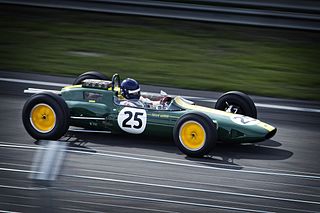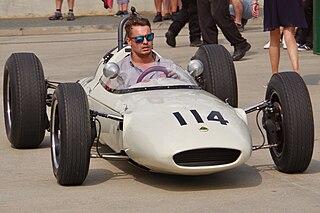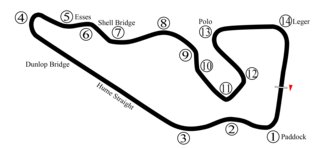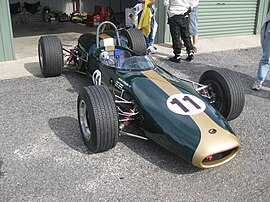Brabham is the common name for Motor Racing Developments Ltd., a British racing car manufacturer and Formula One racing team. Founded in 1960 by Australian driver Jack Brabham and British-Australian designer Ron Tauranac, the team won four Drivers' and two Constructors' World Championships in its 30-year Formula One history. Jack Brabham's 1966 FIA Drivers' Championship remains the only such achievement using a car bearing the driver's own name.

The 1966 Mexican Grand Prix was a Formula One motor race held at the Ciudad Deportiva Magdalena Mixhuca on 23 October 1966. It was race 9 of 9 in both the 1966 World Championship of Drivers and the 1966 International Cup for Formula One Manufacturers. The race was the fifth Mexican Grand Prix and the first to be run under the new three-litre Formula. It was held over 65 laps of the 5 km (3.1 mi) circuit for a race distance of 325 km (202 mi).

The 1967 Formula One season was the 21st season of FIA Formula One motor racing. It featured the 1967 World Championship of Drivers and the 1967 International Cup for F1 Manufacturers, contested concurrently over an eleven race series which commenced on 2 January, and ended on 22 October. The season also included a number of non-championship races for Formula One cars. Denny Hulme won the World Championship of Drivers and Brabham-Repco was awarded the International Cup for F1 Manufacturers.
The 1966 Formula One season was the 20th season of FIA Formula One motor racing. It featured the 1966 World Championship of Drivers and the 1966 International Cup for F1 Manufacturers which were contested concurrently over a nine-race series that commenced on 22 May and ended on 23 October. The season also included a number of non-championship races for Formula One cars.
The 1965 Formula One season, which was the 19th season of FIA Formula One racing, featured the 16th World Championship of Drivers and the 8th International Cup for F1 Manufacturers. The two titles were contested concurrently over a ten-round series which commenced on 1 January and ended on 24 October. The season also included a number of non championship races for Formula One cars.
The 1959 Formula One season was the 13th season of FIA Formula One motor racing. It featured the 1959 World Championship of Drivers and the 1959 International Cup for F1 Manufacturers, contested concurrently over a nine-race series which commenced on 10 May and ended on 12 December. The season also included a number of non-championship Formula One races.

Repco is an Australian automotive engineering/retailer company. Its name is an abbreviation of Replacement Parts Company and it is best known for spare parts and motor accessories.

The Lotus 25 was a racing car designed by Colin Chapman for the 1962 Formula One season. It was a revolutionary design, the first fully stressed monocoque chassis to appear in Formula One. In the hands of Jim Clark it took 14 World Championship Grand Prix wins and propelled him to his 1963 World Championship title. Its last World Championship win was at the 1965 French Grand Prix.

The Lotus 33 was a Formula One car designed by Colin Chapman and Len Terry and built by Team Lotus. A development of the successful Lotus 25, in the hands of Jim Clark it won 5 World Championship Grands Prix in 1965, assisting Clark to his second World Championship.

The Brabham BT19 is a Formula One racing car designed by Ron Tauranac for the British Brabham team. The BT19 competed in the 1966 and 1967 Formula One World Championships and was used by Australian driver Jack Brabham to win his third World Championship in 1966. The BT19, which Brabham referred to as his "Old Nail", was the first car bearing its driver's name to win a World Championship race.

The Repco Brabham BT24 was a Formula One racing car design. It was one of three cars used by the Brabham racing team during their championship-winning 1967 Formula One season. Only three BT24 chassis were ever raced.
The 1964 Tasman Series was an international motor racing series contested in New Zealand and Australia over eight races beginning on 4 January and ending on 2 March. It was the first Tasman Series. The series, which was officially known as the Tasman Championship for Drivers, was organised jointly by the Association of New Zealand Car Clubs Inc. and the Confederation of Australian Motor Sport with the winning driver awarded the Tasman Cup. The championship was open to racing cars using unsupercharged engines of up to 2,500 c.c. capacity.
The 1965 Tasman Series was a motor racing competition staged in New Zealand and Australia for cars complying with the Tasman Formula. The series, which began on 9 January and ended on 1 March after seven races, was the second Tasman Series. It was won by Jim Clark, driving Lotus 32B Coventry Climax.

The Lotus 24 was a Formula One racing car designed by Team Lotus for the 1962 Formula One season. Despite some early success in non-Championship Grands Prix, it was eclipsed by the technically superior Lotus 25 and rarely featured in the points in World Championship races.

Warwick Farm Raceway was a motor racing facility which was in operation from 1960 to 1973. Warwick Farm Raceway hosted numerous major events during its life such as the Australian Grand Prix and rounds of both the Australian Touring Car Championship and the Tasman Series.
The 1965 Australian Drivers' Championship was a CAMS sanctioned Australian national motor racing title open to racing cars complying with the Australian National Formula or the Australian 1½ Litre Formula. The title was contested over a six race series with the winner awarded the 1965 CAMS Gold Star. It was the ninth Australian Drivers' Championship.

The Brabham BT3 is a Formula One racing car. It was the first Formula One design to be produced by Motor Racing Developments for the Brabham Racing Organisation, and debuted at the 1962 German Grand Prix. The Brabham BT3 was the vehicle with which team owner – then two-time World Champion – Jack Brabham, became the first driver ever to score World Championship points in a car bearing his own name, at the 1962 United States Grand Prix. The following year Brabham also became the first driver ever to win a Formula One race at the wheel of an eponymous car, again driving the BT3, at the 1963 Solitude Grand Prix. The BT3 design was modified only slightly to form the Tasman Series-specification Brabham BT4 cars.

The Brabham BT20 is a Formula One car used by the Brabham Formula One team in 1966 and 1967, as well as a number of privateers from 1967 to 1969. The BT20 was the direct successor to the Brabham BT19 which was driven to the World Constructors' title in 1966.

The Repco Brabham BT26 was a Formula One racing car design. A development of the previous BT24, its Repco engines were unreliable, but following a switch to Cosworth DFV engines it scored two World Championship Grand Prix wins and finished runner up in the 1969 World Constructors' Championship.

The Brabham BT7 is a Formula One racing car. It was raced by the Brabham Racing Organisation and several privateers from 1963 to 1966. A development of its predecessor, the Brabham BT3, the car proved to be competitive during 1963 and 1964, taking Dan Gurney to two victories. Technical issues prevented the BT7 from scoring better results. The car was equipped with a more reliable Hewland gearbox compared to the Colotti-Francis in the BT3. Malcolm Sayer from Jaguar Cars was consulted to give input for the revised chassis. The slick aerodynamics proved particularly strong at high speed circuits such as Monza or Spa. Its successor, the BT11, was a slightly altered BT7 aimed for customers such as Rob Walker or Jo Siffert.














